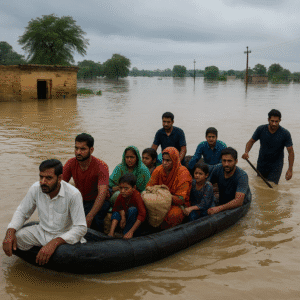A Deluge and a Diplomatic Thaw: Floodwaters Force a Rivalry to the Brink
Facing overwhelming monsoon rains, India released water from swollen dams, triggering a humanitarian crisis downstream in Pakistan. In a significant diplomatic gesture, New Delhi directly alerted Islamabad, breaking a months-long silence between the nuclear rivals. This warning prompted a massive evacuation effort, with over 100,000 people relocated from vulnerable regions in eastern Punjab. The event underscores the critical role of the suspended Indus Waters Treaty, normally governing such water disputes. It highlights how climate change is intensifying monsoons, overwhelming infrastructure and escalating transboundary risks. Ultimately, the crisis reveals that shared environmental threats can force pragmatic, life-saving communication, even amidst deep political hostility.

A Deluge and a Diplomatic Thaw: Floodwaters Force a Rivalry to the Brink
In the fertile, low-lying plains of eastern Pakistan, a familiar seasonal threat has taken on an unprecedented geopolitical dimension. As monsoon rains lashed northern India, swelling rivers and testing the limits of dams, authorities in New Delhi faced a difficult choice. On Monday, they made a critical decision: to release the overwhelming volume of water. And in a move that broke a months-long silence, they sent an urgent alert to their nuclear-armed rival, Pakistan.
The warning, delivered through diplomatic channels on August 25, 2025, triggered a massive evacuation operation across Pakistan’s Punjab province. By Tuesday, over 100,000 citizens—from the districts of Kasur to the border city of Bahawalnagar—were being moved to safer ground, a race against time as the Sutlej River began to swell with the water flowing from upstream.
This event is more than a weather report; it is a stark narrative about climate change, human resilience, and the fragile threads of diplomacy that persist even between the most entrenched adversaries.
The Human Toll: A Race Against the Rising Tide
The response on the ground has been a frantic effort of community and crisis management. In villages like Dhoop Sarhi in Kasur district, rescue workers navigated makeshift boats through submerged streets, helping families clutching their belongings to escape the encroaching waters. The scenes were a painful echo of Pakistan’s recent history, raising fears of a catastrophe on the scale of the 2022 floods that submerged a third of the country.
Nationwide, this year’s monsoon season has already been brutal, claiming over 800 lives in Pakistan since late June. Just weeks earlier, a sudden cloudburst in the northwest’s Buner district killed more than 300 people, highlighting the terrifying unpredictability of modern weather patterns. For those now in the path of the released water, the alert from India, however tense the relations, provided a crucial window to survive.
The Diplomatic Undertow: A Message in the Floodwaters
The method of communication is where the real story lies. India did not use the standard channel—the Indus Waters Commission, a permanent mechanism established under the landmark 1960 Indus Waters Treaty. That treaty, which has survived three wars, was suspended by India months ago following a tragic militant attack on tourists in Kashmir.
Instead, New Delhi used a direct diplomatic note. This marks the first public official contact between the two nations since a dangerous tit-for-tat exchange of missile strikes in May, which was only halted by international mediation.
The subtext is profound:
- A Necessary Gesture: Even amid deep hostility, a basic understanding of humanitarian responsibility prevailed. Allowing a surprise flood to wipe out villages without warning would have been an unconscionable act.
- The Treaty’s Shadow: The event underscores the critical importance of the now-frozen treaty. It was designed precisely for this—to manage shared water resources objectively and avoid conflict. Its absence forces ad-hoc, politically charged communications where technical cooperation should exist.
- A Fragile Thread: This is not a reconciliation, but it is a signal that a line of communication, however narrow, remains open. It proves that on certain existential issues, a sliver of pragmatism can break through.
The Larger Current: Climate Change as the Great Amplifier
Scientists have long warned that climate change is acting as a threat multiplier in South Asia. This season’s “heavier than normal” rains are no anomaly; they are part of a pattern of intensifying monsoons that overwhelm colonial-era infrastructure and defy traditional seasonal expectations.
The 2014 floods in Kashmir, the 2022 deluge in Pakistan, and the current crisis all share a common root. Warmer air holds more moisture, leading to these devastating cloudbursts and relentless downpours. What were once century-level events are becoming frighteningly frequent.
This creates a terrifying feedback loop: climate change increases the frequency of extreme water events, which in turn puts immense strain on the political agreements designed to manage that water peacefully. As resources become scarcer or more volatile, the potential for conflict grows.
Navigating the Future
The images from Punjab are a sobering reminder of human vulnerability. Rescue workers guiding boats through flooded villages represent the brave immediate response to disaster. But the diplomatic memo from New Delhi to Islamabad represents another, more subtle form of rescue—an effort to prevent a natural disaster from escalating into a human-made one.
The event proves that while treaties can be suspended, geography cannot. Rivers will flow across borders, and monsoons will come. The great challenge for India and Pakistan is whether they can rebuild permanent, resilient institutions to manage their shared climate vulnerabilities, or if they will forever be reliant on last-minute warnings between rivals, with the lives of tens of thousands hanging in the balance. The water, after all, waits for no one.
You must be logged in to post a comment.